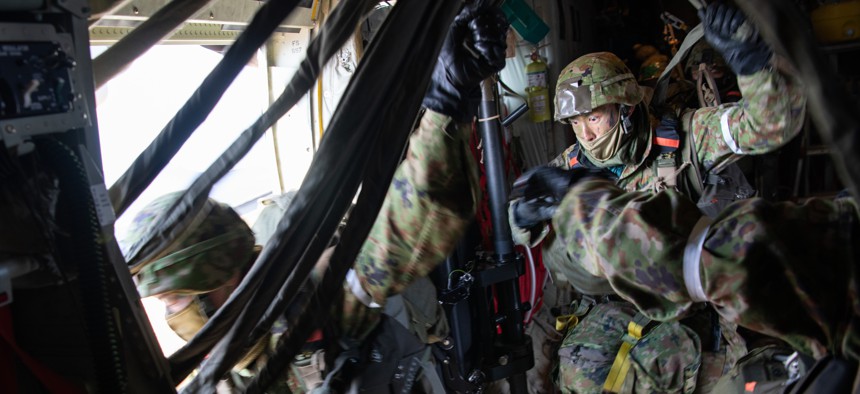
A Japan Ground Self-Defense Force paratrooper assigned to the 1st Airborne Brigade jumps out of a U.S. Air Force C-130J Super Hercules assigned to the 36th Airlift Squadron over the JGSDF East Fuji Maneuver Area, Japan, during Airborne 23, Jan. 31, 2023. U.S. Air Force / Senior Airman Brooklyn Golightly
US wants to build more arms with Pacific allies
Pentagon’s top weapons buyer also touts “industrial-size” 3D printers sent to Ukraine.
The United States will work with Japan to develop a new interceptor to hit hypersonic missiles. And it will work with Australia to produce Guided Multiple Launch Rocket System rockets, or GMLRS.
It’s all part of a new strategy to bring partners into the process of manufacturing key weapons to ensure a steady supply of arms in the event of a major conflict, and to deter China from military action, Pentagon acquisition chief Bill LaPlante said Wednesday.
“Production itself is deterrence. It's as simple as that. The more we work together to expand global capacity of production and sustainment and foster opportunities for even co-develop and co-production and co-sustainment, the better off we will be, and it will be a deterrent,” LaPlante said at the ComDef conference in Virginia.
The United States has been working to develop new cooperative frameworks with partners. Some are huge, well-covered multi-year efforts, like the AUKUS program to co-design and build a submarine with Australia and the United Kingdom. Others, like the SOSA memorandum between the United States and Japan, are smaller in scope.
“You're gonna hear more and more of those. We're working very hard on all of those with our partners and allies,” he said.
LaPlante also said the Defense Department will look to larger and longer-term contracts over multiple years, sometimes called block buying, to help newer, non-traditional defense contractors appease nervous investors and stay in business as well as to persuade established contractors to sustain production of key arms over longer periods. He pointed to the Defense Department’s contracts with SpaceX as a key example of how block buys can help newer tech companies gain a foothold and drive down prices.
“You need to open up for new competitors to come in, which, at that time, was viewed to be SpaceX,” he said. ”Once we went to a block buy, the supply chain [launch prices] stabilized and it's that simple. And again you'll save money. But that's not the only reason you do it. You do it to stabilize and give a steady demand signal.”
The Defense Department is also looking for new ways to manufacture things closer to China to keep supply lines flowing during a conflict. LaPlante cited 3D printers, which Ukrainian soldiers use to create replacement parts near the front lines, as an example of how important near-the-battlefield manufacturing can be to future high-end fights.
“What you have to do, when you can't send your own U.S. citizens into the country to keep the equipment [maintained], we have to do it by telemaintenance. We have to do it in other ways. And of course the Ukrainians are going wild on advanced manufacturing,” he said. “We've provided them seven industrial-size 3D printers, literally the size [of] about a quarter of this room. We're not talking boutique little 3D printers; we're talking gigantic industrial-size 3D printers. And the technical data packages, the intellectual property, that detailed designs for them to print stuff.”
Said LaPlante: “We need to a paradigm shift to meet the needs of today the future fight, which we've been embarking upon over the last year.”




